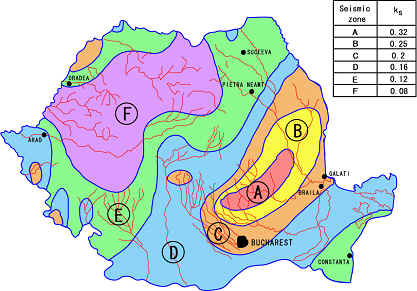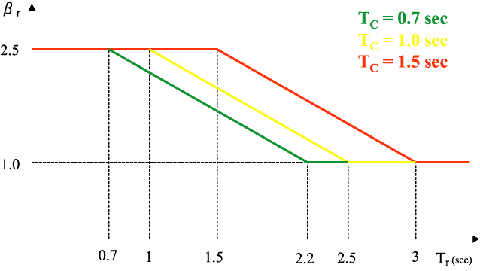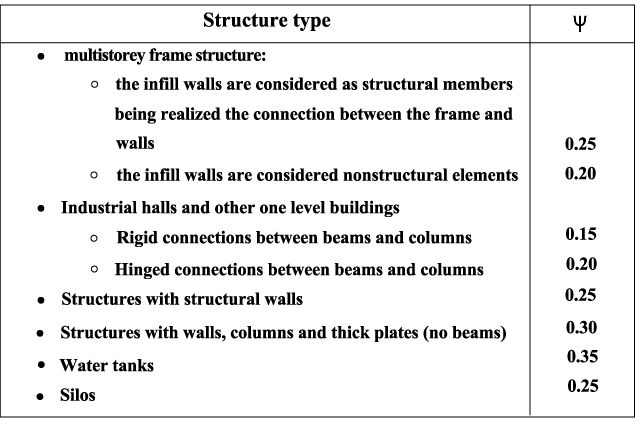Code for aseismic design of residental buildings,
agrzootechnical and
industrial structures (92).
The horizontal seismic loads, acting on a structure, are determined for each natural mode of vibration.
If the natural vibration occur in one plane, the resultant of horizontal seismic loads (base shear force), corresponding to the ground motion direction and to the rth vibration mode, is determine using the following relation:
Sr = cr ×G
Sr:base shear
G – resultant of gravity loads for the whole building
Cr – overall seismic coefficient corresponding to the rth vibration mode.
α – importance coefficient of the building
The “α” coefficient provide differences between buildings aseismic protection level according to the classes of importance they belong to.
α = 1.4 for class Ⅰ importance buildings
α = 1.2 for class Ⅱ importance buildings
α = 1.0 for class Ⅲ importance buildings
α = 0.8 for class Ⅳ importance buildings
Class 1 – Buildings of vital social importance, whose functionality during and immediately after earthquake should be fully granted – hospitals, fire stations, ambulance services
Class 2 – Very important buildings requiring a limitation of damage, keeping in view its potential consequences – schools, churches
Class 3 – Normal importance buildings (not falling into classes 1,2 or 4) – residential buildings, hotels
Class 4 – Reduced importance buildings – agrozootechnical structures of reduced importance
ks = coefficient depending on the seismic zone
The “ks” coefficient represents the ratio between the peak ground acceleration of the seismic motion (with an average recurrence period of about 50 years),
Corresponding to the seismic zone, and the gravity acceleration.
“ks” coefficient values according to the seismic zone

Seismic zonation map of Romania – ks coefficient
βr = dynamic amplification coefficient
The “βr” coefficient depends on the site spectral composition of the seismic motion and is determined according to the natural oscillation periods (Tr) of the building and to the local seismic conditions, characterized by the corner periods (Tc) using the following relations.
βr = 2.5 for Tr ≤ Tc
βr = 2.5 – (Tr – Tc) ≥ 1 for Tr > Tc
βr – Tr” diagram


Seismic zonation map of Romania – Tc corner period
εr – equivalence coefficient
εr – equivalence coefficient between the real system and a system with one degree of
freedom corresponding to the own mode of vibration „r”.

where: ukr – the component of „k” degree of freedom coresponding to the vector „r”
Gk – the resultant of gravitational loads corresponding for level „k”
![]()
Ψ – coefficient of reduction of seismic effects
The Ψ coefficient takes into account:
u Structural ductility,
u Stresses re-distribution capacity,
u Contribution of strength reserve not considered in the analysis,
u Vibration damping effects.
Ψmin = 0.15 for industrial one story reinforced concrete structures with stiff beam-column joints;
Ψmax= 0.65 for steel latticed masts.

 Romania
[
Back to Seismic Design Code Index ] [
Back to Country Index ]
Romania
[
Back to Seismic Design Code Index ] [
Back to Country Index ]